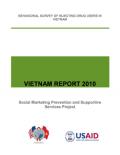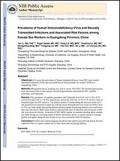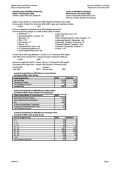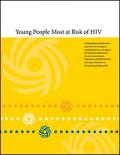What's New
Displaying results 4031 - 4040 of 4914

Resource | Publications,
Between December 2009 and February 2010, PSI Vietnam, in partnership with local research agency, Newcare conducted a behavior survey of male injecting drug users, across seven PEPFAR priority provinces in Vietnam (Ho Chi Minh City, Hanoi, Hai Phong, Quang Ninh, An Giang, Nghe An, and Can Tho). Behavioral and other data relevant to HIV risk were collected, together with a wider range of social and demographic information.

Resource | Publications,
The Master Plan for Drug Abuse Control 2010-2014 has been prepared by the Ministry of Narcotics Control and the Anti Narcotics Force, based on a consultative process through the Steering Committee led by the Anti Narcotics Force.
Objectives have been defined and achievable targets set with emphasis on both supply and demand reduction activities. Lessons learnt from the implementation of the last Master Plan have been addressed. The Master Plan takes into account the impact of the worsening drug situation in Afghanistan during 2006 and 2007 resulting in an unprecedented increase in poppy cultivation.

Resource | Publications,
To assess the prevalence of human immunodeficiency virus (HIV) and sexually transmitted infections (STIs) and associated factors among female sex workers (FSWs) in Guangdong, China. Respondent driven sampling was used to recruit 320 FSWs. The recruited participants were interviewed face-to-face using a structured questionnaire and tested for HIV, syphilis, gonorrhea, and Chlamydia.

Resource | Publications,
This document shows the HIV/AIDS cases in Indonesia thru December 2009 based on the Directorate General CDC and EH Ministry of Health, Republic of Indonesia.

Resource | Publications,
Since acknowledging the HIV/AIDS epidemic, significant efforts to understand the epidemic in China have been undertaken resulting in a comprehensive policy response based on those understandings. From 2003 onwards, China has implemented ambitious treatment, prevention, and control programs, and significant resources to combat HIV/AIDS have been allocated, resulting in increased government infrastructure and capacity. Many successes have occurred since 2003; however, new challenges are emerging, and many previously identified challenges remain and continue to evolve. Although the research effort into properly understanding HIV/AIDS in China continues to expand, it is necessary to translate scientific findings into public health programs, which can be implemented nationwide. China does not yet have the luxury of complacency in its response to HIV/AIDS. This special edition of the AIDS Journal of Acquired Immune Deficiency Syndromes presents research into these new and continuing AIDS challenges.

Resource | Fact Sheets,
In January 2010, there were 143 new HIV Ab seropositive individuals confirmed by the STD/AIDS Cooperative Central Laboratory (SACCL) and reported to the HIV and AIDS Registry (Table 1). This was a 120% increase compared to the same period last year (n=65 in 2009) [Figure 1]. Of the 143 individuals reported, 58 were detected from voluntary counseling and testing (VCT) as part of ongoing community outreach activities.

Resource | Publications,
Amnesty International has prepared this report with the aim of supporting the work of Cambodian women's rights organizations, service providers and others working to protect and defend women and girls who are subjected to rape and other sexual violence. The report is part of Amnesty International's global campaign “Stop Violence Against Women”. It is based on research trips to Cambodia in April and November-December 2009, and draws on interviews in Battambang, Siem Reap, Phnom Penh and Kampong Thom with some 30 female victims of rape from across ten provinces, and around a dozen of their family members. The violations described in the report took place between early 2006 and December 2009.

Resource | Guidelines,
Gender-based violence against women has gained recognition under International law, in the jurisdictions of international courts and tribunals, in the Convention on the Elimination of Discrimination against Women (CEDAW) itself and under the Security Council's effort to broaden their approaches to peace and security. But an intertwined approach is still lacking and a concerted and coherent response from the UN system is needed.
All governments and legal authorities which fail to protect women and to discipline those found responsible for gender-based crimes are guilty of indemnity. Addressing this impunity raises the question of sexual violence, gender discrimination and patriarchal structures.

Resource | Publications,
This paper is designed to call more attention to young people within the groups considered "most at risk" for HIV—those who sell sex, those who inject drugs, and young men who have sex with men. Despite the growing attention that has been given to programming for these groups, little explicit focus has emerged on the particular needs of young people in these populations. At the same time, efforts to prevent HIV among young people have tended to focus on the general population of young people, for whom more is known about effective programming.
Research has begun to show the importance of focusing on young people within most-at-risk populations, and there are increasing examples of programmatic approaches for meeting their needs.

Resource | Publications,
With this 2008-2009 UNGASS report, Viet Nam’s fourth (following reports in 2002-2003, 2004-2005 and 2006-2007), Viet Nam continues to demonstrate its strong commitment to the UNGASS reporting process and to its national response to HIV. Viet Nam considers this fourth report particularly important because it is being completed in 2010, the target year for the 2006 Political Declaration on Universal Access to HIV Prevention, Treatment, Care and Support, of which Viet Nam is also a signatory. This report presents and reflects on both Viet Nam’s achievements as well as on its challenges in responding to HIV, during the 2008-2009 reporting period.





